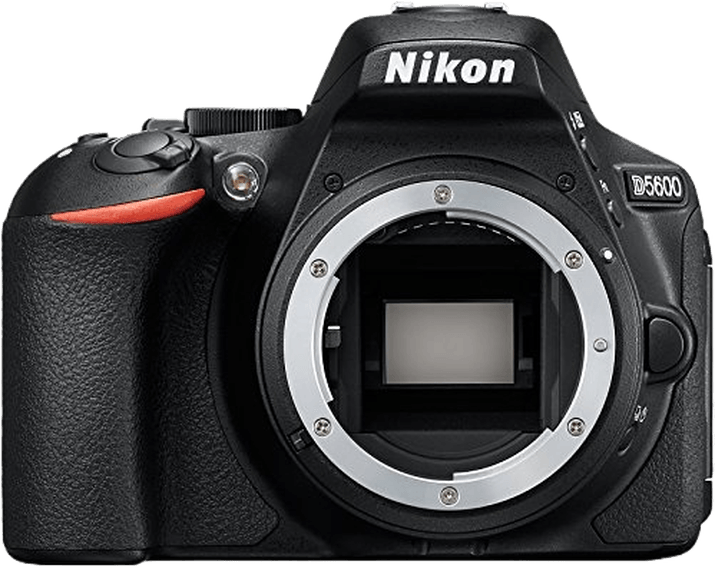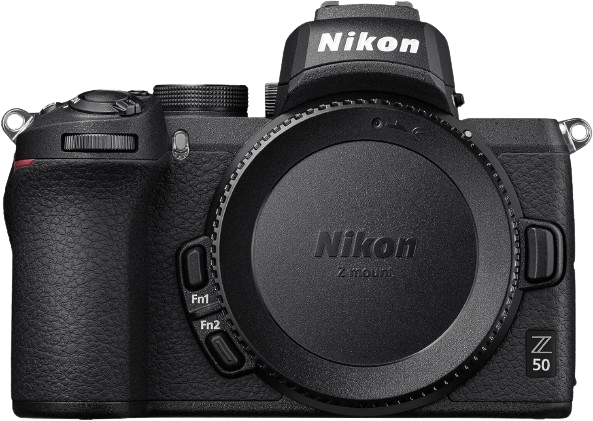Nikon D5600 vs Z50 Comparison
Nikon D5600

Nikon Z50

The Nikon Z50 emerges as the winner with a score of 73/100, while the Nikon D5600 trails behind at 66/100. Both cameras share similarities, such as being released within three years of each other and having a similar size. The Z50, however, boasts a mirrorless design, making it slightly lighter at 450g compared to the D5600’s 465g.
The Z50’s higher score reflects its advantages, such as its more compact size (127 x 94 x 60mm) and more recent release date in 2019. Meanwhile, the D5600 holds its own with a more affordable launch price of $700, compared to the Z50’s $859.
Taking these factors into account, the Nikon Z50 stands out as the better choice for those prioritizing a lighter, more modern camera, while the D5600 offers a budget-friendly option without sacrificing too much in terms of size and weight.
Nikon D5600 vs Z50 Overview and Optics
The Nikon Z50 wins the optics comparison with a score of 72/100, while the Nikon D5600 trails behind at 65/100. Both cameras share common specifications, such as 24.2 and 21 megapixels, CMOS sensor type, APS-C sensor size, and no image stabilization.
The Z50’s superior performance in optics stems from its faster shooting speed of 11, compared to the D5600’s 5. This allows photographers to capture more frames per second, making it ideal for action shots and fast-paced events. The Z50 also boasts a more advanced Expeed 6 processor, contributing to better image quality and processing speed. Additionally, its higher DXOMARK score of 97 for the sensor demonstrates the camera’s ability to produce clearer, more detailed images.
On the other hand, the D5600 has a slightly higher megapixel count at 24.2, compared to the Z50’s 21. This results in larger image files, providing more room for cropping and editing without sacrificing image quality. However, the difference in megapixels is not significant enough to outweigh the advantages offered by the Z50.
Both cameras feature different lens mounts, with the D5600 using the Nikon F DX mount and the Z50 using the Nikon Z mount. The choice of lens mount depends on the photographer’s existing lens collection and intended use. The Nikon F DX mount is compatible with a wider range of lenses, while the Nikon Z mount offers compatibility with newer, high-quality lenses designed specifically for mirrorless cameras.
Considering the points mentioned above, the Nikon Z50 proves to be the better camera in terms of optics due to its faster shooting speed, advanced processor, and higher DXOMARK score. The D5600’s marginally higher megapixel count does not significantly impact its overall performance in comparison.
Nikon D5600 vs Z50 Video Performance
The Nikon Z50 emerges as the winner in the video capabilities comparison with a score of 91/100, while the Nikon D5600 scores 70/100. Both cameras share some common specifications, such as having time-lapse functionality built in.
The Nikon Z50 outperforms the D5600 in terms of video resolution and frame rate. The Z50 offers a maximum video resolution of 4K with dimensions of 3840 x 2160, while the D5600 provides Full HD resolution with dimensions of 1920 x 1080. The higher resolution of the Z50 results in sharper and more detailed video footage. Additionally, the Z50 supports a maximum video frame rate of 120fps, compared to the D5600’s maximum of 60fps. This higher frame rate enables smoother slow-motion footage and greater flexibility in post-production.
The Nikon D5600 does not surpass the Z50 in any video-related specification. However, it still provides quality video performance with its Full HD resolution and 60fps frame rate. The D5600 is suitable for users who do not require the advanced features of the Z50 and prefer a more budget-friendly option.
Considering the specifications, the Nikon Z50 proves to be the superior choice for individuals seeking advanced video capabilities, such as 4K resolution and high frame rates. The Nikon D5600, while not excelling beyond the Z50, remains a viable option for those prioritizing budget and still desiring quality video performance.
Nikon D5600 vs Z50 Features and Benefits
The Nikon Z50 emerges as the winner in the features comparison, scoring 86 out of 100, while the Nikon D5600 scores 72. Both cameras have several common specifications, including a 3.2-inch touchscreen, flip screen, WiFi, and Bluetooth connectivity. However, neither camera has GPS functionality.
The Nikon Z50 surpasses the D5600 in screen resolution, offering 1,040,000 dots compared to the D5600’s 1,037,000 dots. This advantage provides slightly clearer and more detailed images on the Z50’s screen. Furthermore, the Z50’s higher feature score reflects its overall superior performance and additional capabilities.
On the other hand, the Nikon D5600 holds its ground despite its lower feature score. It still offers a competitive set of features, such as the 3.2-inch touchscreen, flip screen, WiFi, and Bluetooth. Although the difference in screen resolution is minimal, the D5600’s screen is still of high quality and offers excellent image display.
After comparing the two cameras, it is evident that the Nikon Z50 is the superior choice due to its higher feature score and marginally better screen resolution. However, the Nikon D5600 remains a viable option for those seeking a camera with a solid set of features. Ultimately, the choice between these two cameras will depend on the individual’s preferences and priorities, as both offer impressive specifications and performance.
Nikon D5600 vs Z50 Storage and Battery
The Nikon D5600 outperforms the Nikon Z50 in storage and battery with a score of 43/100, compared to the Z50’s 35/100. Both cameras possess one memory card slot and accept SD, SDHC, and SDXC (UHS-I compatible) cards for storage.
The D5600’s advantage lies in its battery life, providing 970 shots per charge with its EN-EL14a battery. This significantly surpasses the Z50’s 320 shots using the EN-EL25 battery. The longer battery life of the D5600 makes it a more reliable option for extended shooting sessions.
However, the Z50 has a notable advantage with its USB charging capability. This feature allows for convenient charging on-the-go and eliminates the need for carrying a separate charger. Despite its shorter battery life, the Z50’s USB charging offers flexibility and convenience.
Considering these factors, the Nikon D5600 stands out for its extended battery life, while the Nikon Z50 compensates with its USB charging feature. Ultimately, the choice between these cameras depends on the user’s preference for battery life or charging convenience.
Nikon D5600 vs Z50 – Our Verdict
Are you still undecided about which camera is right for you? Have a look at these popular comparisons that feature the Nikon D5600 or the Nikon Z50:

